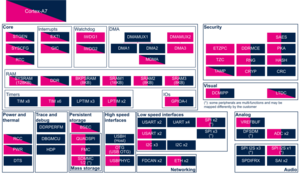Registered User mNo edit summary |
Registered User mNo edit summary |
||
| Line 47: | Line 47: | ||
|} | |} | ||
===== On {{MicroprocessorDevice | device=15}} ===== | ===== On {{MicroprocessorDevice | device=15}} ===== | ||
{{: | {{:STM32MP15_internal_peripherals_software_table_template}} | ||
| Networking | | Networking | ||
| [[FDCAN internal peripheral|FDCAN]] | | [[FDCAN internal peripheral|FDCAN]] | ||
| Line 80: | Line 80: | ||
|} | |} | ||
===== On {{MicroprocessorDevice | device=15}} ===== | ===== On {{MicroprocessorDevice | device=15}} ===== | ||
{{: | {{:STM32MP15_internal_peripherals_assignment_table_template}} | ||
<section begin=stm32mp15 /> | <section begin=stm32mp15 /> | ||
| rowspan="2" | Networking | | rowspan="2" | Networking | ||
Latest revision as of 15:40, 1 February 2022
1. Article purpose
The purpose of this article is to:
- briefly introduce the FDCAN peripheral and its main features
- indicate the level of security supported by this hardware block
- explain how each instance can be allocated to the runtime contexts and linked to the corresponding software components
- explain, when necessary, how to configure the FDCAN peripheral.
2. Peripheral overview
FDCAN peripheral handles data communication in a Controller Area Network (CAN) bus system using message-based protocol originally designed for in-vehicle communication.
The CAN subsystem consists of two CAN modules (FDCAN1 and FDCAN2), a shared message RAM and an optional clock calibration unit.
2.1. Features
Both FDCAN instances are compliant with classic CAN protocol[1] and CAN FD[2] (CAN with Flexible Data-Rate) protocol.
In addition, FDCAN1 supports time triggered CAN (TTCAN).
FDCAN1 and FDCAN2 share a dedicated 10 Kbyte CAN SRAM for message transfers.
Refer to STM32MP13 reference manuals or STM32MP15 reference manuals for the complete list of features, and to the software components, introduced below, to see which features are implemented.
2.2. Security support
FDCAN is a non secure peripheral.
3. Peripheral usage and associated software
3.1. Boot time
The FDCAN is not used at boot time.
3.2. Runtime
3.2.1. Overview
FDCAN instances can be allocated to:
- the Arm® Cortex®-A7 non-secure core to be controlled in Linux® by the NetDev framework (See CAN overview)
- the Arm® Cortex®-M4 to be controlled in STM32Cube MPU Package by STM32Cube FDCAN driver
3.2.2. Software frameworks
3.2.2.1. On STM32MP13x lines 
| Domain | Peripheral | Software components | Comment | |
|---|---|---|---|---|
| OP-TEE | Linux | |||
| Networking | FDCAN | Linux net/can framework | ||
3.2.2.2. On STM32MP15x lines 
| Domain | Peripheral | Software components | Comment | ||
|---|---|---|---|---|---|
| OP-TEE | Linux | STM32Cube | |||
| Networking | FDCAN | Linux net/can framework | STM32Cube FDCAN driver | ||
3.2.3. Peripheral configuration
The configuration is applied by the firmware running in the context to which the peripheral is assigned. The configuration can be done alone via the STM32CubeMX tool for all internal peripherals, and then manually completed (particularly for external peripherals) according to the information given in the corresponding software framework article. When the FDCAN peripheral is assigned to the Linux® OS, it is configured through the device tree according to the information given in the FDCAN device tree configuration article.
3.2.4. Peripheral assignment
3.2.4.1. On STM32MP13x lines 
Click on the right to expand the legend...
| Domain | Peripheral | Runtime allocation | Comment | ||
|---|---|---|---|---|---|
| Instance | Cortex-A7 secure (OP-TEE) |
Cortex-A7 non-secure (Linux) | |||
| Networking | FDCAN | FDCAN1 | ☐ | ||
| FDCAN2 | ☐ | ||||
3.2.4.2. On STM32MP15x lines 
Click on the right to expand the legend...
| Domain | Peripheral | Runtime allocation | Comment | |||
|---|---|---|---|---|---|---|
| Instance | Cortex-A7 secure (OP-TEE) |
Cortex-A7 non-secure (Linux) |
Cortex-M4 (STM32Cube) | |||
| Networking | FDCAN | FDCAN1 | ☐ | ☐ | Assignment (single choice) | |
| FDCAN2 | ☐ | ☐ | Assignment (single choice) | |||
4. References
- ↑ CAN protocol implementations, from the CAN in Automation group (CiA)
- ↑ CAN FD - The basic idea, from the CAN in Automation group (CiA)

